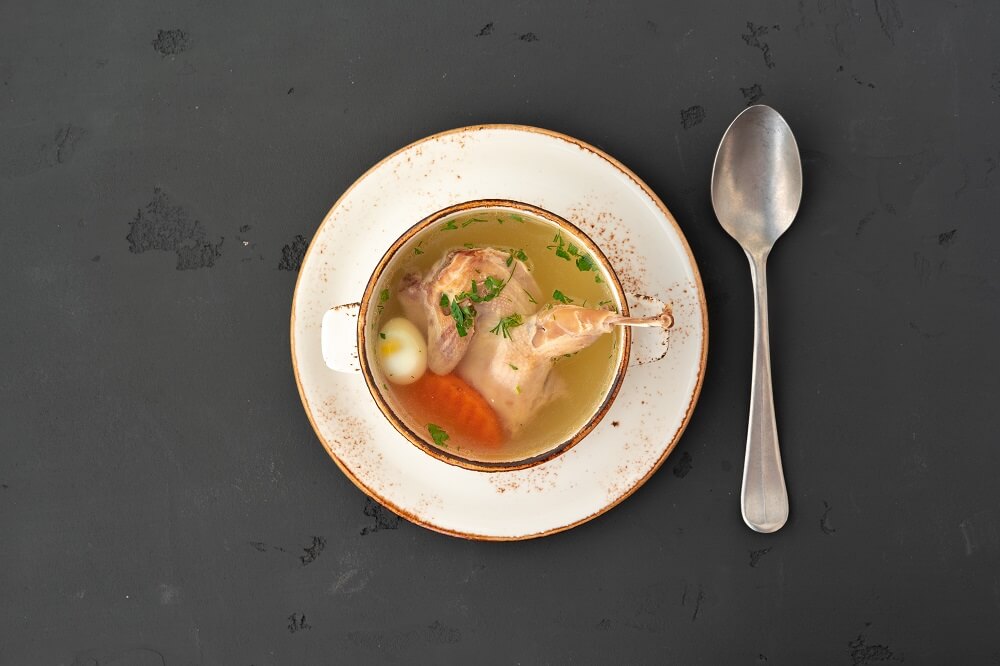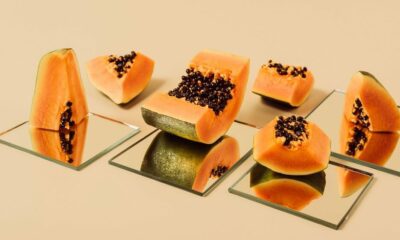Food & Recipes
What To Eat During Viral Fever? 7 Best And Worst Foods To Eat When You Are Sick
Published
3 years agoon
By
David

A virus causes viral fever, which is characterized by a higher-than-normal body temperature. While not everyone with a virus has a fever, it is a sign that the body is trying to fight the infection.
Most viral disorders will improve with patience and supportive therapy such as cold compresses and over-the-counter (OTC) medications. On the other side, a high body temperature may demand medical attention.
The viral fever normally lasts 3-5 days, with a few symptoms dissipating after a few more days. For some viruses, however, the cycle can be prolonged, and the recovery time from a viral fever might continue up to two weeks. You should consult a doctor if the symptoms of viral fever last longer than two weeks. And now the question arises,
What to eat in viral fever?
Food is always something everyone is scared about when anyone is sick. Even when you are sick with a common cold, there are some dangerous diseases like cardiovascular disease. The first thing that arises in the mind is what to eat and what not to. Food has always been the key to curing any disease. good food that is a good choice of food can help you get better along with the doctor prescribed medicines. It is important to give importance to the food you can assume when you are sick along with the medicines you take.
7 food to eat when sick with flu
1. Broth


Brought is considered to be the best diet for fever. It contains all the essential protein acquired from chicken beef or pork broth. It is a rich source of all the minerals. It is easy to digest. It is usually served hot which gives warmth to the throat and also helps the body to be hydrated.
2. Yogurt


Yogurt with live cultures can help ease a sore throat while simultaneously boosting your immune system. Protein is also found in yogurt.
While your throat is painful, you can have yogurt, but make sure to buy complete yogurts without added sweeteners.
3. Fruits high in vitamin C


Vitamin C is a crucial mineral for supporting your immune system, which is especially vital while you’re unwell. While supplements can assist, your body can absorb minerals like vitamin C better from foods.
While you’re sick with the flu, try munching on vitamin C-rich fruits. Strawberries, tomatoes, and citrus fruits are examples of vitamin C-rich fruits.
4. Garlic


While you may think of garlic as a taste element, it has been utilized in alternative medicine for ages to treat several maladies. Garlic supplements were proven to improve immunity and lower symptom severity in individuals with the flu in one research.
However, you do not need to take supplements. Garlic is eaten raw may also be healthy. Consider consuming garlic at the first sign of the flu because of its immune-boosting properties.
5. Greens with lots of leaves


When you have the flu, spinach, kale, and other leafy greens can help improve your immune system. They include vitamin C as well as vitamin E, an immune-boosting ingredient.
Make a smoothie with leafy greens and fruit, or eat them raw with a splash of lemon and olive oil. It’s great if you eat these immune-boosting foods all the time while you’re sick.
6. Broccoli


Broccoli is a nutrient-dense vegetable that can help your body recover from the flu. One serving of this dish contains immune-boosting vitamins C and E, as well as calcium and fiber.
When your appetite returns during the middle or end of the flu, try broccoli. You can also consume broccoli soup; just keep an eye on the sodium content.
7. Spices


You may experience greater sinus and chest congestion as the illness progresses. Pepper and horseradish are great food to eat during the flu, for example, they can help break up congestion so you can breathe easier. When you have a sore throat, though, stay away from spicy meals.
7 Foods to avoid during fever
1. Caffeinated beverages and alcoholic beverages


When you have a fever, you should be aware of dehydration because of the higher temperatures and increased sweating. Caffeine and alcohol might exacerbate your symptoms (particularly stomach-related problems), so stay hydrated by drinking water and other clear drinks throughout the day.
2. Greasy Foods


Foods that are tough to digest and taxing on your gastrointestinal system should be avoided. Saturated fat-rich foods, as well as fried and greasy foods, should be avoided or reduced.
3. Grain that is difficult to digest


Because the flu can often cause stomach trouble, it’s best to eat meals that are easier to digest, such as simple/refined carbs. Foods that are easy on the stomach, such as dry saltine crackers, toast, and pretzels, are the most likely to be tolerated while you have the flu. Foods high in fiber, on the other hand, are more difficult to digest, so I’d recommend avoiding them at first.
4. High fiber
Avoid foods high in fiber with a fever, such as whole wheat grains and cereals. Your digestive system will become tired of breaking down the food molecules since they take longer to digest.
5. Sugary foods and beverages


When you’re sick, you might believe the greatest thing to drink is vitamin-c-rich fruit juices, but most of these options aren’t nutritionally packed and can inflame your immune system. To stay hydrated, I recommend drinking water and other clear beverages.
6. Dairy products


Dairy products have the potential to raise your body temperature. As a result, avoid taking them if you have a temperature.
7. Washing
To ensure that germs on fresh fruits are rinsed away, soak them in water, wash them well, and peel them before eating. Saltwater is a superior alternative for washing fruits since it kills more bacteria than plain water.
FAQs
Coconut water during fever?
Coconut water is free of germs (pyrogen-free: a substance that causes fever). It’s been discovered to be particularly effective in natural oral rehydration therapy (ORT). “Coconut water has been shown to lower fever when eaten under feverish conditions,” he explains. “It is also used to treat nervous and emotional disorders.
Do bananas cause coughing?
This is why bananas are frequently served as part of a breakfast meal, allowing one to start the day without worrying about the following one. It is recommended that you avoid eating it at night, according to Ayurveda, because it aggravates cough and cold. It takes a long time to digest and can make you feel sluggish.
Can we eat chicken with a fever?
When you’re sick with a fever, chicken is perfectly fine to eat. However, the most crucial factor to consider is the type of chicken that is consumed. Chicken recipes with little oil and spices will keep you going while you’re unwell.
Is curd good for coughing?
Vitamins, potassium, magnesium, and protein abound in curd. Lactobacillus aids in the prevention of dangerous microorganisms and illnesses in the body. Curd, being a fermented food, is high in vitamin C, which is beneficial in the treatment of colds and coughs.
Is turmeric milk good for fever?
Turmeric milk is a nutritious Indian beverage made with simple milk and turmeric powder. This is an age-old cure for fever, cold, and cough that is still commonly used in most Indian households.
When you’re sick, resting, staying hydrated, and eating well are some of the most important things you can do to feel better and recover faster.
Fortunately, many meals have health benefits in addition to delivering nutrition to your body. While no meal can heal a disease on its own, eating the appropriate foods can support your immune system and provide relief from some symptoms.
About the author
David is a blogger for over 15 years now and writes on health and wellness. The articles are focused to give extensive information about the subject.
- June 30, 2020
- June 30, 2020
- June 30, 2020
David is a blogger for over 15 years now and writes on health and wellness. The articles are focused to give extensive information about the subject.


You may like
Food & Recipes
Wild Lettuce: Know Wild Lettuce Benefits, Side Effects & More
Wild lettuce, scientifically known as Lactuca virosa, is a biennial plant belonging to the Asteraceae family. Native to Europe and Asia, this herbaceous species is widely cultivated for its medicinal and culinary uses.
Published
5 months agoon
May 17, 2024By
David

What is Wild Lettuce?
Wild lettuce, scientifically known as Lactuca Virosa, is a biennial plant belonging to the Asteraceae family. Native to Europe and Asia, this herbaceous species is widely cultivated for its medicinal and culinary uses. Also referred to as “opium lettuce” due to its mild sedative effects, wild lettuce has a long history of traditional use dating back to ancient civilizations.
The plant has deeply lobed leaves and little yellow flowers that bloom in bunches. It normally reaches a height of 3 to 7 feet. You can find wild lettuce growing in meadows, woodlands, and by the sides of roads in temperate areas. Because of its adaptability and persistence, it is frequently seen in both urban and rural environments.
Wild lettuce has long been valued for its medicinal qualities as well as being seen as a representation of life and wellbeing. Ancient societies, including the Greeks, Romans, and Egyptians, appreciated the sedative, analgesic, and anti-inflammatory qualities of wild lettuce. It was frequently applied to reduce pain, encourage calmness, and bring on sleep.
In contemporary times, wild lettuce continues to be cherished for its medicinal benefits and is widely used in herbal medicine practices around the world. Its leaves and sap contain a milky latex substance known as lactucarium, which is rich in bioactive compounds such as lactucin and lactucopicrin. These compounds are believed to contribute to the plant’s sedative and analgesic effects, making it a popular remedy for conditions such as insomnia, anxiety, and migraine headaches.
Despite its long history of traditional use, wild lettuce remains a subject of scientific inquiry, with ongoing research aimed at uncovering its pharmacological properties and potential therapeutic applications. As interest in natural remedies and alternative medicine continues to grow, wild lettuce holds promise as a valuable botanical resource for promoting health and well-being.
Can We Eat Wild Lettuce
The answer is that wild lettuce is edible, and you can eat the leaves and stems of the plant. Nevertheless, care must be taken when gathering and cooking wild lettuce for eating. Some people may find the bitter flavour of certain wild lettuce species to be intolerable.
Furthermore, some people may respond negatively to some substances found in wild lettuce, particularly if they ingest excessive amounts of it or if they have particular sensitivities or allergies.
Consequently, it is best to start modestly while consuming wild lettuce in order to monitor your body’s response and make sure the plant is being harvested in a clean and healthy setting.
As with any wild plant, it is crucial to positively identify the species and to avoid harvesting from areas that may be exposed to pollutants or pesticides. If you have any concerns or medical conditions, it is best to consult with a healthcare professional before consuming wild lettuce or any other wild plant for culinary or medicinal purposes.
The Medicinal Uses of Wild Lettuce
Wild lettuce has a long history of use in traditional medicine for its various medicinal properties. From alleviating pain to promoting relaxation, this versatile plant offers a range of therapeutic benefits that have been recognized and valued for centuries.
1. Pain relief:
Wild lettuce has been traditionally used to alleviate pain associated with various conditions such as headaches, muscle aches, and joint pain. Research suggests that wild lettuce contains compounds like lactucin and lactucopicrin, which exhibit analgesic properties by acting on the central nervous system to reduce pain perception (source).
2. Sedative properties:
The milky sap of wild lettuce contains lactucarium, a substance known for its sedative effects. Studies have shown that lactucarium acts as a mild sedative and can help promote relaxation and improve sleep quality (source).
3. Anxiety and stress relief:
Wild lettuce may help alleviate symptoms of anxiety and stress due to its calming effects on the nervous system. Research indicates that wild lettuce extracts have anxiolytic properties, making them useful in managing stress and anxiety (source).
4. Respiratory support:
Wild lettuce has been used to relieve respiratory conditions such as asthma and bronchitis. Studies suggest that compounds in wild lettuce possess expectorant and bronchodilator effects, which can help improve breathing and relieve coughs (source).
5. Digestive aid:
The bitter compounds in wild lettuce can stimulate digestive function, improve appetite, and alleviate symptoms of indigestion. Research shows that wild lettuce extracts may have gastroprotective effects and help reduce gastric acid secretion (source).
6. Mild diuretic:
Wild lettuce can act as a mild diuretic, promoting urine production and helping to eliminate excess fluid and toxins from the body. Studies suggest that wild lettuce extracts may increase urine output and support kidney function (source).
7. Anti-inflammatory effects:
Compounds found in wild lettuce may help reduce inflammation and swelling, making it beneficial for conditions such as arthritis. Research indicates that wild lettuce extracts exhibit anti-inflammatory activity by inhibiting inflammatory mediators (source).
8. Nervous system support:
Wild lettuce is believed to have a tonic effect on the nervous system, helping to calm nerves and reduce irritability. Studies suggest that wild lettuce extracts may modulate neurotransmitter levels in the brain, contributing to its calming effects (source).
9. Menstrual cramp relief:
Some women use wild lettuce to alleviate menstrual cramps and discomfort during menstruation. While scientific research on this specific use is limited, anecdotal evidence suggests that wild lettuce may help reduce menstrual pain and cramping.
10. Fever reducer:
Wild lettuce has been traditionally used to lower fever and promote sweating during febrile illnesses. However, more research is needed to fully understand its mechanisms of action and effectiveness in reducing fever.
11. Antispasmodic properties:
Wild lettuce may help relieve muscle spasms and cramps due to its antispasmodic effects on smooth muscle tissue. Studies suggest that wild lettuce extracts can relax muscle contractions and alleviate spasms (source).
12. Liver support:
Consuming wild lettuce may support liver function and detoxification processes. While there is limited direct research on this aspect, the liver-supporting properties of bitter herbs like wild lettuce are well-documented in traditional medicine (source).
13. Hypnotic effects:
Wild lettuce preparations have been used to induce a state of mild euphoria and relaxation, promoting restful sleep and reducing insomnia. Studies suggest that wild lettuce extracts may have sedative-hypnotic effects, aiding in sleep induction (source).
14. Traditional remedy for opiate withdrawal:
Wild lettuce has been historically used as a natural remedy to help ease symptoms of opiate withdrawal, such as anxiety, restlessness, and insomnia. While scientific evidence is limited, anecdotal reports suggest that wild lettuce may offer relief during the withdrawal process.
15. Skin conditions:
Wild lettuce sap has been applied topically to soothe skin irritations, rashes, and insect bites. While there is limited scientific research on this specific use, the anti-inflammatory and analgesic properties of wild lettuce may help alleviate skin discomfort (source).
Potential Side Effects of Wild Lettuce
1. Allergic reactions:
Some individuals may experience allergic reactions to wild lettuce, leading to symptoms such as skin rash, itching, swelling, or difficulty breathing. Allergic reactions can vary in severity, and it’s essential to discontinue use if any adverse reactions occur (source).
2. Gastrointestinal discomfort:
Consuming wild lettuce may cause gastrointestinal discomfort in some people, including symptoms like nausea, vomiting, diarrhea, or abdominal pain. These effects can be due to the bitter compounds present in wild lettuce, which may irritate the digestive tract (source).
3. Drowsiness and dizziness:
Wild lettuce’s sedative properties may cause drowsiness or dizziness, especially when consumed in large amounts or in combination with other sedative substances. These effects can impair cognitive function and motor skills, increasing the risk of accidents or injuries (source).
4. Hypotension:
Some individuals may experience a drop in blood pressure after consuming wild lettuce, leading to symptoms of hypotension such as lightheadedness, fainting, or weakness. Individuals with low blood pressure or those taking antihypertensive medications should use wild lettuce with caution (source).
5. Photosensitivity:
Certain compounds in wild lettuce sap may increase sensitivity to sunlight, leading to sunburn or skin irritation upon exposure to UV rays. Individuals using wild lettuce topically should avoid prolonged sun exposure to prevent skin reactions (source).
6. Potential drug interactions:
Wild lettuce may interact with certain medications, including sedatives, antihypertensives, and blood thinners. These interactions can potentiate the effects of medications or interfere with their metabolism, leading to adverse reactions or reduced efficacy (source).
7. Liver toxicity:
In rare cases, excessive consumption of wild lettuce may lead to liver toxicity or liver damage. This adverse effect is more likely to occur with prolonged or high-dose use of wild lettuce preparations (source).
8. Respiratory depression:
Wild lettuce’s sedative properties may cause respiratory depression in susceptible individuals, particularly those with respiratory conditions like asthma or chronic obstructive pulmonary disease (COPD). Respiratory depression can lead to breathing difficulties or even respiratory failure in severe cases (source).
9. Pregnancy and breastfeeding:
Pregnant and breastfeeding women should avoid using wild lettuce due to a lack of safety data. Wild lettuce may exert uterine-stimulating effects and pose risks to fetal development or infant health (source).
10. Psychological effects:
In some cases, wild lettuce may induce psychological effects such as confusion, hallucinations, or altered perception. These effects are more likely to occur with high doses or prolonged use of wild lettuce and can be distressing or disorienting (source).
About the author
David is a blogger for over 15 years now and writes on health and wellness. The articles are focused to give extensive information about the subject.
- June 30, 2020
- June 30, 2020
- June 30, 2020
Food & Recipes
Best Juices To Boost Immune System For a Stronger Defense
Published
7 months agoon
April 3, 2024By
Charlotte

In today’s fast-paced world, maintaining a robust immune system is crucial for overall health and well-being. While a balanced diet rich in fruits and vegetables forms the cornerstone of immune health, incorporating immunity-boosting juices into your daily routine can provide an extra layer of protection against illness. In this comprehensive guide, we delve into the benefits of immunity-boosting juices and share delicious recipes to help fortify your body’s natural defenses.
Immunity Booster Drink: The Power of Healthy Juices
1. Watermelon-Mint Immunity Juice:


- Ingredients: Fresh watermelon chunks, mint leaves, lime juice.
- Benefits: Watermelon is a rich source of vitamin C, antioxidants, and electrolytes, making it an ideal ingredient for boosting immune function. Mint leaves not only impart a refreshing flavor but also contain compounds that support digestion and overall well-being. Lime juice adds an extra dose of vitamin C, further enhancing the immune-boosting properties of this juice.
- Recipe: To prepare this refreshing elixir, simply blend fresh watermelon chunks and mint leaves until smooth. Squeeze in some fresh lime juice for added zest. Serve chilled for a hydrating and invigorating boost to your immune system.
Nutrients
- Vitamin C from watermelon and lime
- Hydration from watermelon and coconut water
- Antioxidants from watermelon and mint
2. Citrus Immunity Blast:


- Ingredients: Oranges, grapefruits, lemons, ginger.
- Benefits: Citrus fruits like oranges, grapefruits, and lemons are renowned for their high vitamin C content, which plays a crucial role in supporting immune health. These fruits also provide essential antioxidants that help combat oxidative stress and inflammation. Ginger adds an extra layer of immune support with its anti-inflammatory and antimicrobial properties.
- Recipe: Juice fresh oranges, grapefruits, and lemons to extract their vibrant and tangy flavors. Add freshly grated ginger for an additional boost of immune-boosting goodness. Enjoy this invigorating citrus blast over ice for a refreshing and revitalizing way to support your immune system.
Nutrients
- Vitamin C from oranges and lemons
- Vitamin A from carrots
- Antioxidants from oranges, carrots, and turmeric
- Hydration from coconut water
3. Green Goddess Elixir:


- Ingredients: Spinach, kale, cucumber, apples, lemon.
- Benefits: Eating leafy greens like spinach and kale are nutritional powerhouses, packed with vitamins A, C, and K, as well as essential minerals and antioxidants. These nutrients help bolster immune function and protect against illness. Cucumber adds hydration and a refreshing crunch, while apples and lemon provide natural sweetness and acidity.
- Recipe: Blend together fresh spinach, kale, cucumber, apples, and lemon until smooth. Strain the mixture if desired, then sip on this nutrient-rich elixir to nourish your body and support your immune system. This Green Goddess Elixir is a delicious and rejuvenating way to boost your overall health.
Nutrients
- Vitamin A, C, and K from spinach and cucumber
- Calcium from spinach
- Iron from spinach
- Magnesium from spinach and cucumber
- Potassium from spinach and cucumber
- Antioxidants from spinach, cucumber, celery, and lemon
- Hydration from cucumber and celery
- Detoxifying properties from spinach, cucumber, celery, lemon, and parsley
4. Berry Blast Immunity Booster:


- Ingredients: Mixed berries (strawberries, blueberries, raspberries), spinach, Greek yogurt, honey.
- Benefits: Berries are packed with antioxidants, vitamins, and minerals that help strengthen the immune system and protect against free radical damage. Spinach adds additional vitamins and minerals, while Greek yogurt contributes probiotics that support gut health and overall immune function. Honey provides natural sweetness and antimicrobial properties.
- Recipe: Blend together a mix of fresh berries, spinach, Greek yogurt, and honey until smooth and creamy. Adjust the sweetness to taste, then enjoy this delicious and nutritious Berry Blast Immunity Booster as a satisfying snack or meal replacement. This vibrant and flavorful juice is sure to keep your immune system strong and resilient.
Nutrients
- Vitamin C from strawberries and oranges
- Antioxidants from berries and spinach
- Fiber from berries and spinach
- Hydration from coconut water
5. Tropical Turmeric Tonic:


- Ingredients: Pineapple, mango, turmeric root, ginger, coconut water.
- Benefits: Pineapple and mango are tropical fruits rich in vitamins A and C, which are essential for immune function. Turmeric and ginger both have potent anti-inflammatory and antioxidant properties that can help strengthen the immune system and reduce inflammation. Coconut water provides hydration and electrolytes, making this tonic both refreshing and nourishing.
- Recipe: Blend together chunks of fresh pineapple and mango with grated turmeric root, ginger, and coconut water until smooth. Strain the mixture if desired, then pour into glasses and garnish with a slice of pineapple or a sprig of mint. Sip on this Tropical Turmeric Tonic to give your immune system a tropical boost and enjoy the vibrant flavors of the islands.
Nutrients
- Vitamin C from pineapple
- Antioxidants from pineapple, mango, turmeric, and ginger
- Electrolytes and hydration from coconut water
6. Beetroot Bliss Booster:


- Ingredients: Beetroot, carrots, oranges, ginger, honey.
- Benefits: Beetroot is rich in immune-boosting nutrients like vitamin C, folate, and manganese, as well as powerful antioxidants called betalains. Carrots provide additional vitamins and minerals, while oranges add a zesty burst of vitamin C. Ginger and honey contribute antimicrobial properties and natural sweetness, respectively.
- Recipe: Juice fresh beetroot, carrots, and oranges to extract their vibrant colors and flavors. Add freshly grated ginger and a drizzle of honey to enhance the taste and nutritional value. Enjoy this Beetroot Bliss Booster as a delicious and invigorating way to support your immune system and promote overall health.
Nutrients
- Vitamin C from oranges
- Folate, manganese, and betalains from beetroot
- Antioxidants from beetroot, carrots, and oranges
7. Pomegranate Power Punch:


- Ingredients: Pomegranate seeds, strawberries, spinach, lemon, honey.
- Benefits: Pomegranate seeds are packed with antioxidants, particularly punicalagins and anthocyanins, which help boost immune function and reduce inflammation. Strawberries provide additional vitamin C and fiber, while spinach adds vitamins A and K. Lemon adds a citrusy kick and extra vitamin C, while honey lends natural sweetness and antimicrobial properties.
- Recipe: Blend together fresh pomegranate seeds, strawberries, spinach, lemon juice, and honey until smooth and creamy. Pour into glasses and garnish with a slice of lemon or a few pomegranate arils. Sip on this vibrant and nutrient-rich Pomegranate Power Punch to give your immune system a powerful boost and enjoy the delicious flavors of summer.
Nutrients
- Vitamin C from pomegranate seeds and lemon
- Antioxidants from pomegranate seeds, strawberries, and spinach
- Fiber from strawberries and spinach
8. Detoxifying Green Cleanse:
- Ingredients: Cucumber, celery, kale, green apples, lemon, parsley.
- Benefits: This green juice is packed with detoxifying ingredients that help cleanse the body and support immune health. Cucumber and celery are hydrating and low in calories, while kale provides vitamins A, C, and K. Green apples add natural sweetness, while lemon and parsley provide additional vitamin C and antioxidants.
- Recipe: Juice together cucumber, celery, kale, green apples, lemon juice, and parsley until well combined. Strain the mixture if desired, then pour into glasses and enjoy this Detoxifying Green Cleanse as a refreshing and revitalizing way to support your immune system and promote overall wellness.
Nutrients
- Vitamin A, C, and K from kale
- Hydration from cucumber and celery
- Detoxifying properties from kale, cucumber, celery, and parsley
By incorporating these immunity-boosting juices into your daily routine, you can provide your body with the essential nutrients it needs to stay healthy and resilient. Whether enjoyed as a refreshing beverage or a post-workout pick-me-up, these delicious juices offer a convenient and delicious way to support your immune system and promote overall well-being.
About the author



Charlotte
Charlotte is a health, beauty and wellness blogger and a mother of two, who lives between India and London
- July 22, 2020
- August 3, 2020
- August 10, 2020
Food & Recipes
Diabetic-Friendly Delights: Nourishing Recipes for Managing Blood Sugar
Living with diabetes necessitates meticulous attention to your diet to maintain optimal blood sugar levels and overall health. Through a carefully curated selection of recipes and insightful guidance, this comprehensive guide is designed to empower you with the knowledge
Published
7 months agoon
March 26, 2024By
Charlotte

Living with diabetes necessitates meticulous attention to your diet to maintain optimal blood sugar levels and overall health. Through a carefully curated selection of recipes and insightful guidance, this comprehensive guide is designed to empower you with the knowledge and tools to make informed dietary choices that support blood sugar control while savoring the pleasures of a delicious and nourishing meal plan.
Understanding Diabetes Management Through Diet


Embark on a journey into the realm of diet and diabetes, where the crucial link between what you eat and blood sugar control becomes evident. This section delves into the nuances of balancing your diet to maintain stable blood sugar levels, revealing how strategic meal planning contributes to overall wellness.
The Importance of Balanced Nutrition
Discover the power of balanced nutrition in managing diabetes. We unravel the significance of incorporating nutrient-rich foods that provide essential vitamins, minerals, and antioxidants while helping to keep blood sugar levels in check. Learn how to create harmonious meals that cater to your taste buds and your health.
Incorporating Low Glycemic Index (GI) Foods


Navigate the world of glycemic index foods, where the speed at which carbohydrates affect blood sugar levels is demystified. Dive into a selection of low GI recipes that embrace wholesome ingredients, allowing you to indulge in satisfying meals without compromising blood sugar control.
Sweetening Naturally
Bid farewell to refined sugars and explore the realm of natural sweeteners. Delve into alternatives such as stevia, monk fruit, and honey, discovering innovative ways to infuse sweetness into your dishes while maintaining stable blood sugar levels.
Protein-Packed Pleasures


Unlock the secrets of protein’s role in managing diabetes. Beyond its muscle-building attributes, protein contributes to steady blood sugar levels. Explore a variety of high-protein meals, recognizing how they promote muscle health and assist in maintaining balanced glucose levels.
Smart Carbohydrate Choices
Navigate the complex world of carbohydrates with wisdom. Discover how to identify diabetes-friendly carbs, explore the benefits of whole grains, and understand the impact of carbohydrates on blood sugar levels. Make informed choices to enjoy sustained energy and well-being.
Heart-Healthy Fats


Learn the importance of heart-healthy fats in diabetes care. This section highlights the significance of omega-3 fatty acids and monounsaturated fats, shedding light on their role in supporting cardiovascular health and blood sugar management.
Healthy Cooking Methods
Discover the art of cooking for blood sugar control. Uncover cooking methods that preserve nutrients and flavors while minimizing the impact on blood sugar levels. From grilling to steaming, explore techniques that elevate your culinary endeavors.
Colorful Fruits and Vegetables


Embrace a vibrant palette of fruits and vegetables that not only add color to your plate but also offer a treasure trove of essential nutrients. The rainbow diet is unveiled, showcasing how these nutrient-rich foods can contribute to your overall well-being.
Diabetes and Hydration


Staying hydrated is often overlooked in diabetes care. Recognize the profound influence of proper hydration on blood sugar management and overall health. Learn about the role of water intake in supporting your well-being.
Embrace this journey toward diabetic-friendly delights, where each recipe and insight is tailored to empower you in your pursuit of balanced blood sugar levels and holistic well-being. By understanding the nuances of nutrition, making informed food choices, and crafting meals that harmonize with your diabetes management goals, you’re embarking on a path of wellness that nourishes both body and spirit.
Living with diabetes doesn’t mean sacrificing flavor or indulgence. In fact, it’s an opportunity to explore a world of delectable and nourishing dishes that support your blood sugar management while satisfying your taste buds. This blog presents a collection of mouthwatering recipes that embrace the principles of balanced nutrition, low glycemic index (GI) foods, and mindful ingredient choices. Get ready to embark on a culinary journey that combines taste and health in perfect harmony.
Nourishing Recipes for Managing Blood Sugar
Recipe 1: Quinoa-Stuffed Bell Peppers
Ingredients:
- 4 large bell peppers (any color)
- 1 cup quinoa, rinsed
- 2 cups low-sodium vegetable broth
- 1 can (15 oz) black beans, drained and rinsed
- 1 cup corn kernels (fresh or frozen)
- 1 cup diced tomatoes
- 1 teaspoon cumin
- 1 teaspoon paprika
- Salt and pepper to taste
- Chopped fresh cilantro for garnish
Instructions:
- Preheat the oven to 375°F (190°C).
- Cut the tops off the bell peppers and remove the seeds and membranes.
- In a medium saucepan, bring the vegetable broth to a boil. Add the quinoa, reduce heat to low, cover, and let it simmer for about 15 minutes or until the liquid is absorbed.
- In a large bowl, combine the cooked quinoa, black beans, corn, diced tomatoes, cumin, paprika, salt, and pepper. Mix well.
- Stuff each bell pepper with the quinoa mixture and place them in a baking dish.
- Cover the baking dish with aluminum foil and bake for 25-30 minutes, or until the peppers are tender.
- Garnish with chopped cilantro before serving.
Recipe 2: Baked Salmon with Asparagus
Ingredients:
- 2 salmon fillets
- 1 bunch asparagus, trimmed
- 2 tablespoons olive oil
- 1 lemon, sliced
- 2 cloves garlic, minced
- Salt and pepper to taste
Instructions:
- Preheat the oven to 400°F (200°C).
- Place the salmon fillets and asparagus on a baking sheet lined with parchment paper.
- Drizzle olive oil over the salmon and asparagus. Sprinkle minced garlic, salt, and pepper.
- Place lemon slices on top of the salmon fillets.
- Bake in the preheated oven for about 15-20 minutes or until the salmon flakes easily with a fork and the asparagus is tender.
- Serve with a squeeze of fresh lemon juice.
Recipe 3: Greek Yogurt Parfait
Ingredients:
- 1 cup plain Greek yogurt
- 1/2 cup mixed berries (blueberries, strawberries, raspberries)
- 1 tablespoon chopped nuts (almonds, walnuts)
- 1 teaspoon chia seeds
- 1 teaspoon honey (optional)
Instructions:
- In a glass or bowl, layer half of the Greek yogurt.
- Add a layer of mixed berries on top of the yogurt.
- Sprinkle chopped nuts and chia seeds over the berries.
- Add the remaining Greek yogurt on top.
- Drizzle honey over the yogurt, if desired.
- Enjoy as a nutritious and satisfying dessert or snack.
These recipes exemplify the essence of diabetic-friendly delights—delicious, nutritious, and mindful of blood sugar levels. By incorporating these recipes into your meal plan, you’re embracing a journey of wellness and culinary exploration. Remember, managing diabetes doesn’t mean giving up on the joy of food; it’s about making choices that nourish your body and elevate your overall well-being.
About the author



Charlotte
Charlotte is a health, beauty and wellness blogger and a mother of two, who lives between India and London
- July 22, 2020
- August 3, 2020
- August 10, 2020
Trending
-



 Health & Wellness3 months ago
Health & Wellness3 months ago10 Amazing Papaya Benefits That Will Blow Your Mind
-



 Health & Wellness3 months ago
Health & Wellness3 months agoDischarge Before Period: Causes, Symptoms, and Management
-
Love & Relationship2 months ago
Micro-Cheating: Understanding the Subtle Signs of Infidelity
-



 Health & Wellness2 months ago
Health & Wellness2 months agoAre There Any Benefits in Semen Retention: Not ejaculating for 7 days
-



 Love & Relationship2 months ago
Love & Relationship2 months ago360 Deep Conversation Starters: Unlock Meaningful Discussions








